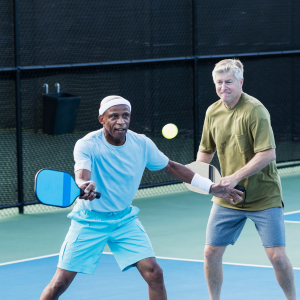
Do you have back pain? Or knee pain? Or have you needed a hip replacement? Believe it or not, despite the injury, part (or most) of the solution may be increasing hip strength. In this article we will discuss what is meant by “hip” strength, why hip strength is important, and provide our favorite hip exercises to improve strength!
What is “Hip” Strength?

The hip consists of many different muscles, and it is important to strengthen the front and back of the hip for mobility.
The muscles in the hip contribute to so many functional movements, including standing from a toilet, getting in and out of a car, walking, squatting down to pick up a grandchild, and being able to lift items from the floor.
In this article, we are mostly going to focus on the back of the hips, also known as the glutes.
The back of our hips (or back of the body in general) tend to be a muscle group that doesn’t get enough work.
Ironically, it may be the most important for our function and for preventing pain because those posterior (which means back) muscles are our power house!
When the glutes and posterior hip muscles are strong, we have better alignment at the knee and ankle when we walking, which helps prevent pain in the leg. Also, we don’t have to compensate for weak hips by overusing our back, which helps prevent back pain.
What Muscles Are We Talking About?

The highlighted names above are not only the glutes (Gluteus maximus, Gluteus medius, Gluteus minimus), but also the deep rotators of the hip.
The glutes help with rotation and extension of the hip, help stabilize the upper body, and help with motion.1
The deep rotators are needed to keep the joint together when we are walking, jogging, playing pickleball, basically doing any movement!
Strengthening these muscles will help us be able stay more active, with less risk of injury, and hopefully less need for a hip replacement in the future!
As an extra bonus, even if you do need a hip replacement, strengthening these muscles before the surgery will likely help you recover more quickly and efficiently!
6 Exercises to Help Increase Hip Strength
Click HERE for a video of Dr. Katie Landier, PT, DPT, GCS completing the exercises!
1. Clamshells
- Lie on your side, placing your head on your bottom arm for support
- Place knees and feet together
- Bend knees towards chest
- Rotate bottom foot so toes are pressing slightly down into the mat
- Keep heels together, toes apart
- Lift top knee away from bottom knee
- Complete 10-15 reps
- Rest for 1-3 minutes
- Repeat for 3 sets
- Repeat on other side
2. Reverse Clamshells
- Lie on your side, placing your head on your bottom arm for support
- Place knees and feet together
- Bend knees towards chest
- Rotate bottom foot so toes are pressing slightly down into the mat
- Lift top leg away from bottom leg
- Rotate top knee towards bottom knee
- Rotate top knee towards ceiling
- This is one rep
- Complete 10-15 reps
- Rest for 1-3 minutes
- Repeat for 3 sets
- Repeat on other side
3. Sidelying Legs
- Lie on your side, placing your head on your bottom arm for support
- Place knees and feet together
- Bend bottom knees toward chest for stability
- Keeping top leg straight, lift it towards the ceiling (don’t lift too high- just lift it until it’s in line with the torso)
- Slowly lower the leg back down to starting position
- Complete 10-15 reps
- Rest for 1-3 minutes
- Repeat for 3 sets
- Repeat on other side
4. Sidelying Legs with Band
- Take long resistance band and place center of it under the bottom of your foot/shoe
- Wrap one end of the band around the top of the foot/shoe (band should not be tight/cutting off circulation)
- Lie on your opposite side, placing your head on your bottom arm for support and long straps of band under your bent bottom knee for support
- Keeping top leg straight, lift it towards the ceiling (don’t lift too high- just lift it until it’s in line with the torso)
- Slowly lower the leg back down to starting position
- Complete 10-15 reps
- Rest for 1-3 minutes
- Repeat for 3 sets
- Repeat on other side
5. Standing Hip Abduction
- Place a looped band (or tie long resistance band) above the knees
- Stand with a stable surface to one side, placing hand on surface for balance
- Have a slight bend in your standing leg
- Lift opposite leg out to the side without leaning
- Repeat 10-15 reps
- Rest for 1-3 minutes
- Repeat for 3 sets
- Repeat on other side
6. Standing Hip Extension
- Place a looped band (or tie long resistance band) above the knees
- Stand with a stable surface in front of you, placing hands on surface for balance
- Have a slight bend in your standing leg
- Lift opposite leg behind you without leaning or bending the knee
- Repeat 10-15 reps
- Rest for 1-3 minutes
- Repeat for 3 sets
- Repeat on other side
Have the Strength to Live Life to the Fullest!
Please Remember to Subscribe and Check out our YouTube Channel!
Sources:
- https://www.physiopedia.com/Gluteal_Muscles#:~:text=minimus%20(red).-,Function,internal%20rotation%20of%20the%20thigh.



